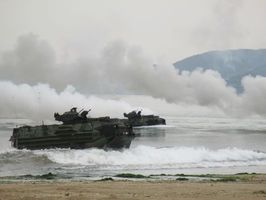![635927917232337008-635926938545971491-Marines-go-ashore.jpg [image : 81371306]](http://www.gannett-cdn.com/media/2016/03/05/USATODAY/USATODAY/635927917232337008-635926938545971491-Marines-go-ashore.jpg)
The U.S. military is holding exercises in South Korea amid increased tensions with North Korea, whose leader Kim Jong Un has ordered his country’s nuclear weapons to be at the ready.
About 2,100 Marines and sailors recently arrived in South Korea for exercise Ssang Yong 16, which began on Wednesday and lasts until March 20, Marine Corps officials said.
Held every two years, the exercise involves U.S. and South Korean troops conducting amphibious operations for possible disaster relief or wartime missions, said 2nd Lt. Joshua Hays, a Marine Corps spokesman.
Meanwhile, North Korea has recently tested a nuclear weapon and fired six projectiles into the sea, said Bruce Klingner, a Korea expert at the Heritage Foundation think tank in Washington, D.C.
![Philippines to seize N. Korean cargo ship under U.N. sanctions [oembed : 81371482] [oembed : 81371482] [oembed : 81371482] [oembed : 81371482]](/Portals/_default/Skins/PrestoLegacy/CommonCss/images/smartembed.png)
“Things could get dicey in the next couple months,” Klingner said in an interview. “We’re already seeing North Korea starting to issue threats: If the U.S. doesn’t stop these exercises or doesn’t cancel these exercises, North Korea may take appropriate action.
“They also highlight that there are a number of strategic assets that will be part of it: nuclear-capable submarines, B-52s, F-22s, etc., special forces Marines — all of which, in North Korean eyes, or the North Korean depiction, is a prelude to an attack on North Korea.”
It is unclear whether North Korea actually believes that the exercise is camouflage for an invasion by the U.S. and South Korea or the North is trying to frighten South Korea into canceling the exercise, but with the militaries from both sides operating so closely to each other, the chances of something going wrong increases, Klingner said.
“In their statements, they certainly declare that they see the potential for a U.S. attack,” he said. “They will point to U.S. attacks on Libya and Iraq and Serbia as indicative of what the U.S. and its allies might do to them.”
The North Koreans are particularly wary of seeing Marines on the Korean peninsula, Klingner said. In September 1950, Marines and soldiers launched an amphibious landing at Inchon that stopped the North Korean advance south and led to U.N. forces crossing the 38th parallel into North Korea.
![635927917232337008-635926938545971491-Marines-go-ashore.jpg [image : 81371306]](http://www.gannett-cdn.com/-mm-/9a860a363dae9158431b218266ebb4d020e8f9d2/c=0-0-469-401/local/-/media/2016/03/05/USATODAY/USATODAY/635927917232337008-635926938545971491-Marines-go-ashore.jpg)
“The North Koreans ... know the history of the Marine Corps, so they would see a large presence of Marines on the peninsula as possibly a prelude to an attack or an invasion — especially when it’s coupled with the presence of B-52s and nuke-capable submarines,” Klingner said.
The current exercise, however, was scheduled long before the most recent tensions on the Korean peninsula, said retired Army Special Forces Col. David Maxwell, associate director at the Center for Security Studies at Georgetown University. For decades, the U.S. has held combined military exercises with South Korea during this time of year to send a message to North Korea.
The North Korean military is about to finish its winter training cycle, when it will be at its highest state of readiness, Maxwell said in an interview.
“That’s important because this month and next month are the optimal times for the invasion of the South, where the ground is still hard and the rice paddies have not been flooded,” he said. “That makes the best time for maneuver on the peninsula.”
By bringing U.S. and South Korean forces to a high state of readiness, the alliance is letting North Korea know that it would be unwise to attack, Maxwell said.
“I believe the North Korean leadership, the military leaders in particular, are smart enough to know that you don’t attack into strength,” Maxwell said.


